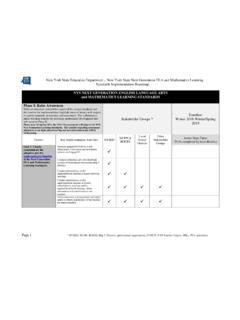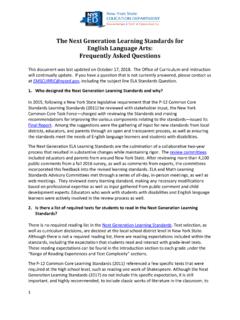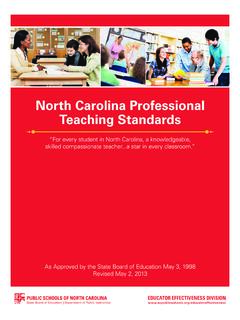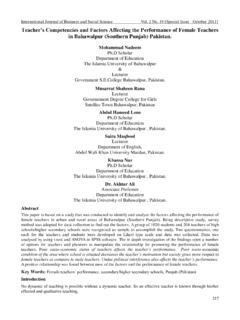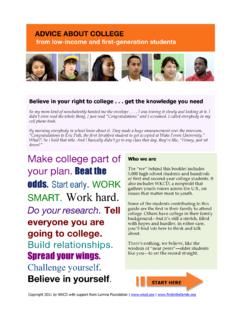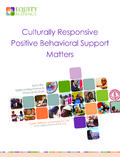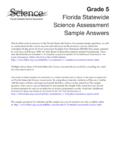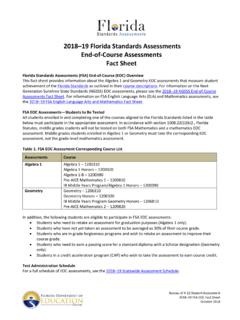Transcription of Looking at Life Cycles - VDOE
1 Science Enhanced Scope and Sequence Grade 2 Virginia Department of Education 2012 1 Looking at life Cycles Strand life Processes Topic Animal and plant life Cycles Primary SOL The student will investigate and understand that plants and animals undergo a series of orderly changes as they mature and grow. Key concepts include a) animal life Cycles ; b) plant life Cycles . Related SOL The student will demonstrate an understanding of scientific reasoning, logic, and the nature of science by planning and conducting investigations in which a) observations and predictions are made and questions are formed; c) observations are repeated to ensure accuracy; g) conditions that influence a change are identified and inferences are made; j) conclusions are drawn; k) observations and data are communicated; l) simple physical models are designed and constructed to clarify explanations and show relationships; m) current applications are used to reinforce science concepts.
2 Background Information All plants and animals go through stages of development which are called the life cycle . A life cycle is the order of the stages in growth of animals and plants and is defined as the complete succession of changes undergone by an organism during its life . Plants go from the seed to a mature plant. Plant life Cycles are not addressed in this lesson. All animals reproduce young of the same kind. Mammals, reptiles, amphibians, birds, fish, insects and other invertebrates each have their own unique way of reproducing life . There is a variety of life Cycles within the animal world. In most mammals the stages of life go from the fertilized egg, to the infant, the juvenile, and then to the adult. Humans and white tailed deer have this kind of life cycle . Birds go from the egg, to the chick, to the adult while amphibians are born (either alive from their mother or hatched from eggs), spend their childhood under water, breathing with gills, and later change to an adult form and breathe at least partly through lungs.
3 This transformation process is called metamorphosis. Certain species of amphibians, particularly among the salamanders, remain in larval form all their lives. Mealworms display a convenient animal life cycle for students to observe because they are inexpensive (a whole class can be outfitted with individual setups for about $3) and they go through their life cycle rapidly enough for classroom use. Science Enhanced Scope and Sequence Grade 2 Virginia Department of Education 2012 2 The mealworm is the larva stage of the grain beetle, which goes through four stages. The first stage is the egg, which is only about one millimeter in length. Eggs hatch in about one week. The next stage is the larva (mealworm), the stage at which the students will begin their observations. This stage lasts two to three weeks.
4 During this stage, the mealworm sheds its skin several times. The third stage is the pupa. In this stage, the mealworm transforms into its adult form, the grain beetle. The pupa stage lasts about two weeks. After becoming a beetle, it lays eggs, and the cycle begins anew. Grain beetles lay up to 500 eggs in their lifetimes. Insects go from the egg, to the larva, to the pupa, to the adult. A butterfly is an insect and has this kind of metamorphic life cycle . A butterfly begins as an egg. The larva, called a caterpillar, hatches from an egg. As it grows, it sheds its skin and grows a new one. It eats a great deal in the caterpillar stage. Shedding its skin one last time, it becomes a pupa. It is covered in a hard shell, called a chrysalis. The adult butterfly breaks out of its chrysalis, lays eggs, and the life cycle begins anew.
5 White-tailed deer are an excellent example of a simple life cycle that is the life cycle of most mammals, including humans. The life cycle includes the infant stage when the baby looks very similar to its parents and is dependent on them for survival. The next stage is that of a youth. Again, the deer looks much like its parents, but is beginning to become more independent. The final stage is that of adult. It may help to not think of life Cycles as a circle the way we do the water, carbon, or nitrogen Cycles but to think of life Cycles as a spiral. Each twist in the spiral is a generation and one generation does not end when another begins; there is an overlap of generations. All organisms go through stages of development. The life cycle of an organism refers to the sequence of developmental stages that it passes through on its way to adulthood.
6 Basic animal needs sometimes change from one stage in a life cycle to the next. Studying life Cycles helps scientists make sure that the environment needed is there for animals at their different stages of development. It helps them control things such as disease transmission which might only occur during a certain stage of the life cycle of an organism, or in the case of farmers, be able to recognize the life stages in their crops to know when to harvest, fertilize or treat their crops. Materials Popular children s literature about the life cycle of a butterfly from egg to butterfly Popular children s literature about the life cycle of mammals including humans Mealworms (available at most pet stores for about a dollar for 100) Clear plastic cups one for each student Plastic wrap or baggies Rubber bands Oatmeal Small plastic zip bags Blank booklets one for each student (construction paper folded in half as the cover and three sheets of plain paper folded in half as pages) Strips of paper Bean seeds Cotton balls Science Enhanced Scope and Sequence Grade 2 Virginia Department of Education 2012 3 Yarn Pictures of animal life stages (include animals with a simple life cycle such as the white-tailed deer or squirrels)
7 And include animals that have a metamorphic life cycle (butterfly, mealworms, etc.) Pictures of vegetable plants or fruit trees at their various life stages Vocabulary Metamorphic, mammals, life cycle Student/Teacher Actions (what students and teachers should be doing to facilitate learning) Introduction 1. Read a children s book about the life cycle of a butterfly. After reading the book aloud, have the students tell the cycle . 2. Also read a children s book about the life cycle of a mammal such as white-tailed deer or squirrels. Ask children to compare the two life Cycles . How are they different and how are they alike? Procedure The procedure is divided into several different activities, each of which may take more than one class period to complete. Procedure: Activity 1 1. Show pictures of the butterfly life cycle , and discuss the four distinct stages (egg, larva, pupa, and butterfly).
8 Introduce information about the mealworm life cycle , and compare this to the butterfly life cycle . 2. Set up the mealworm experiment for each student. Give each student a cup, plastic wrap (or a baggie), and some oatmeal. Have the students put the oatmeal in their cups, and give each student three to six mealworms. Have the students cover the cup with the plastic and secure it with a rubber band. Punch two holes in the plastic. 3. Distribute booklets to students, and let them title their booklet with life cycle of a Grain Beetle and make a title page. 4. Have the students draw their mealworm setup they just created on the page after the title page, labeling the page Mealworm Stage. They may want to measure their worms and add this information to the page. Have them put the date on this page.
9 5. The students should observe their mealworms every day. Each day that they note any change (molting of skin, pupa stage developing, etc.), they should draw and write about it in their booklets. Be sure that they date the entry of each change. 6. After all the students mealworms have transformed, place them in one larger container containing oatmeal. Over the next couple weeks, have the students observe the hatching of new mealworms! Procedure: Activity 2 1. Discuss the life cycle of a plant. Show pictures of a variety of plants, pointing out blossoms and fruits on the plants. Discuss that the blossoms develop into fruit. Science Enhanced Scope and Sequence Grade 2 Virginia Department of Education 2012 4 2. Give each student a strip of paper. Have them draw the life cycle of a plant in sequence: seed, sprout, developing leaves, blossoms, and fruit.
10 Discuss that the fruit is or contains the seed for the life cycle to begin again. Have students label each stage on their strip. 3. Discuss what a plant needs to grow (prompt for water, oxygen, nutrients, space, and sunlight). Discuss that while the seed is in the earth, it receives no sunlight, but it does receive heat to cause it to sprout. 4. Distribute plastic zip baggies, yarn, a cotton ball, and a bean seed to each student. 5. Have the students wet the cotton ball and place it in the baggie with their seed. Then have them seal their baggie, punch a whole near the top, tie the yarn on it, and put it around their neck with the baggie against their skin. Explain that they will provide the heat to make their seed sprout. Tell them they should wear this for the next few days and keep it under their pillow at night, not around their neck when they sleep.










